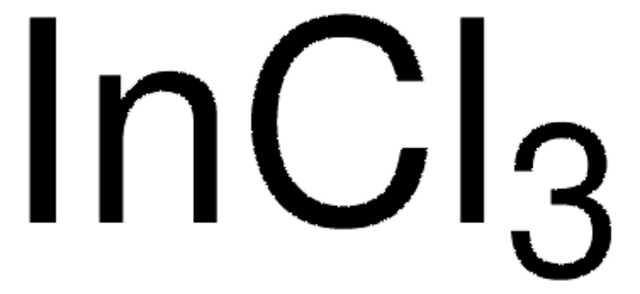Kluczowe dokumenty
651745
Copper(I) chloride
AnhydroBeads™, ≥99.99% trace metals basis
Synonim(y):
Copper monochloride, Cuprous chloride
About This Item
Polecane produkty
klasa czystości
for synthesis
synthesis grade
Poziom jakości
ciśnienie pary
1.3 mmHg ( 546 °C)
linia produktu
AnhydroBeads™
Próba
≥99.99% trace metals basis
przydatność reakcji
reagent type: catalyst
core: copper
zanieczyszczenia
≤100.0 ppm Trace Metal Analysis
bp
1490 °C (lit.)
mp
430 °C (lit.)
rozpuszczalność
slightly soluble 0.47 g/L at 20 °C
Zastosowanie
battery manufacturing
ciąg SMILES
Cl[Cu]
InChI
1S/ClH.Cu/h1H;/q;+1/p-1
Klucz InChI
OXBLHERUFWYNTN-UHFFFAOYSA-M
Szukasz podobnych produktów? Odwiedź Przewodnik dotyczący porównywania produktów
Opis ogólny
Zastosowanie
Informacje prawne
wyposażenie dodatkowe
Hasło ostrzegawcze
Danger
Zwroty wskazujące rodzaj zagrożenia
Zwroty wskazujące środki ostrożności
Klasyfikacja zagrożeń
Acute Tox. 4 Dermal - Acute Tox. 4 Oral - Aquatic Acute 1 - Aquatic Chronic 1 - Eye Dam. 1 - Skin Irrit. 2
Kod klasy składowania
8A - Combustible corrosive hazardous materials
Klasa zagrożenia wodnego (WGK)
WGK 3
Temperatura zapłonu (°F)
Not applicable
Temperatura zapłonu (°C)
Not applicable
Środki ochrony indywidualnej
dust mask type N95 (US), Eyeshields, Faceshields, Gloves
Wybierz jedną z najnowszych wersji:
Masz już ten produkt?
Dokumenty związane z niedawno zakupionymi produktami zostały zamieszczone w Bibliotece dokumentów.
Klienci oglądali również te produkty
Produkty
Nanostructured Materials Through Ultrasonic Spray Pyrolysis
Thermoelectric Performance of Perovskite-type Oxide Materials
Spectral conversion for solar cells is an emerging concept in the field of photovoltaics, and it has the potential to increase significantly the efficiency of solar cells. Lanthanide ions are ideal candidates for spectral conversion, due to their high luminescence efficiencies and rich energy level structure that allows for great flexibility in the upconversion and downconversion of photons in a wide spectral region (NIR-VIS-UV).
Nanostructured Materials Through Ultrasonic Spray Pyrolysis
Global Trade Item Number
| SKU | GTIN |
|---|---|
| 651745-25G | 4061833599846 |
| 651745-5G | 4061832732626 |
Nasz zespół naukowców ma doświadczenie we wszystkich obszarach badań, w tym w naukach przyrodniczych, materiałoznawstwie, syntezie chemicznej, chromatografii, analityce i wielu innych dziedzinach.
Skontaktuj się z zespołem ds. pomocy technicznej










